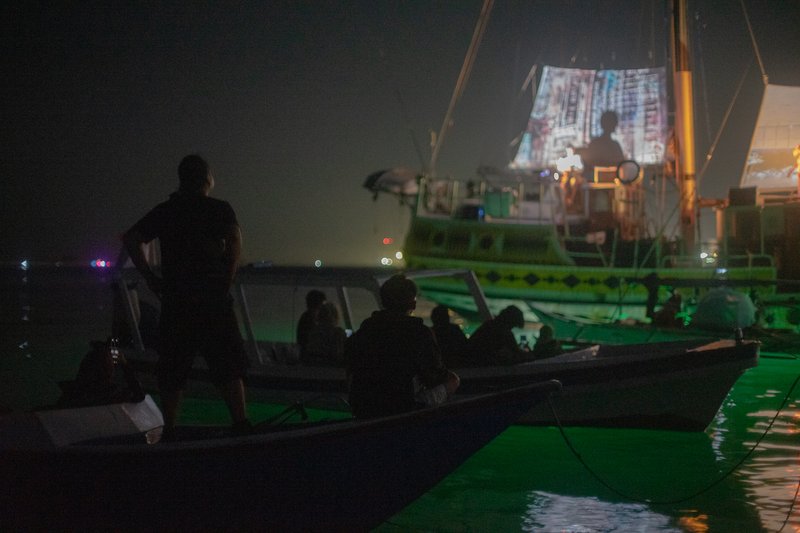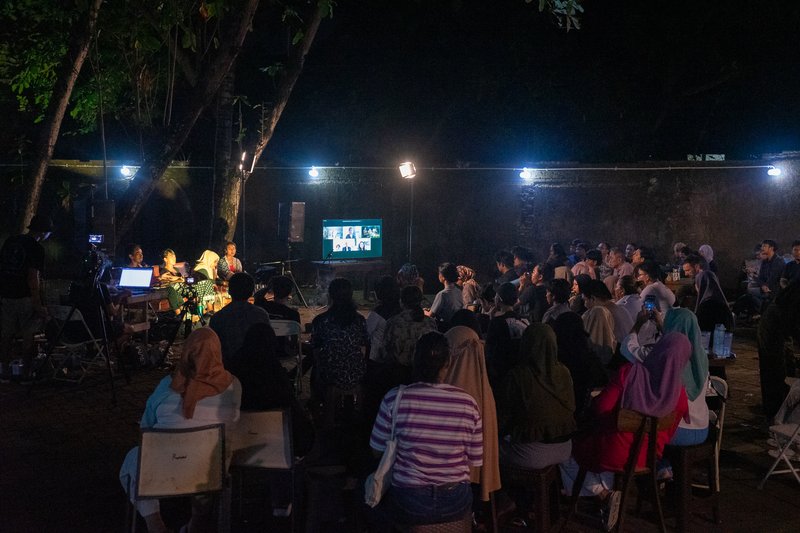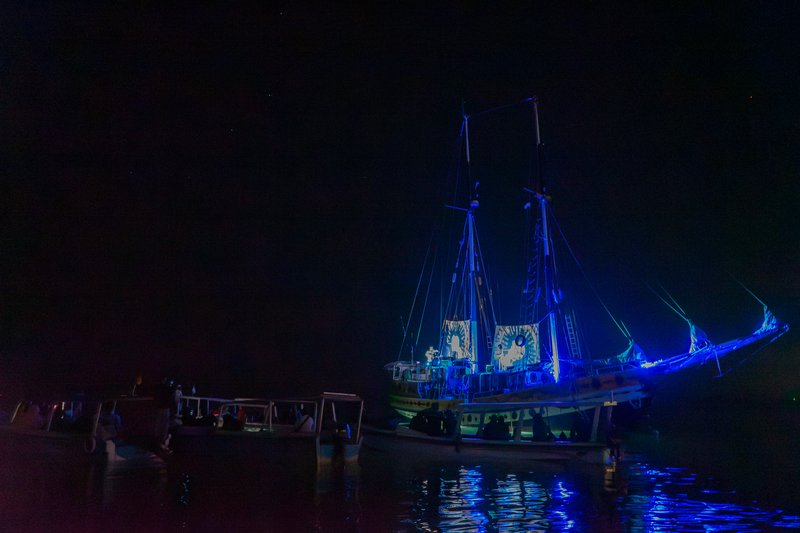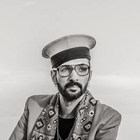Makassar
The City
Makassar is Indonesia’s saltiest city. Plankton swims in the blood of the Makassarese, whether that blood be descended from Goan, Bugis, Chinese or Arab. All roads radiate out from the waterfront and the city has retained some history and charm. In fact, with neither a highway or mega-malls fouling its center, Makassar remains one of the most walkable cities of Indonesia. Not that anyone walks in the oppressive heat. Except me, to enjoy art-deco and mid-century facades crumbling into decadence. The many neon signs, now universally broken, leads me to believe this was once a boomtown. Whatever past moment of glory has now faded to a humble commerce of pawn shops, ship supply warehouses, and street vendors hawking passion-fruit syrup or coconuts.
The neighborhood adjacent to the port is a sailor’s dream, shop after shop selling bilge pumps, spools of rope, sundry cables, and any other imaginable ship part. Is this what posh people feel in Dubai? To have all the things you want, right there for the buying!
This is my fourth visit to Makassar, and I’ve already developed habits, the most sacrosanct being a sunset visit to roof of the grotty Chinese restaurant named “Semarang”. It’s rare to be able to enjoy cold beer al fresco to the soundtrack of magrib azan (evening call to prayer), all the while keeping a watchful eye on our ship at anchor in the bay below. When I imagined touring this country by sail, a scene just like this was in my mind’s eye, and the reality of it is just as satisfying as my imagination.

The Conference
I often overshare the journey and undershare the destinations, which is the content, the work, the purpose. What I chose to share is rooted in bias, because I experience our performances and workshops many times, and they are largely the same, while the journey and locations constantly change. I might only notice novelty, but our work in Makassar was fresh even to my jaded eyes.
The Arka Kinari team had organized a conference on women and the sea, aka #shefarers (see photos). The conference started with the documentary film Silence of the Blue Ocean, which launched a discussion about displacement of local fisherfolk and waste-recyclers by a reclamation project aiming to fill in parts of Makassar bay, and generally mall-ify the port. Makassar maybe not ruined yet, but there are property speculators having a go at it. Fortunately they’ve been blocked by badass coastal fisherfolk, and we had the honor of hosting the resistance leaders. You didn’t have to understand bahasa Indonesia to grasp the meaning of all the battle cries and raised fists. After more films and panels the event moved outside more music, international panels with guests Zoomed in from Japan, Germany, and Jakarta, the whole thing simultaneously translated and live-streamed. The best part about the event? I didn’t lift a finger. Our team was aware that I would be stressed out on my first journey as a new captain and managed the event among themselves. Three years ago none of our crew knew each other and had never done anything like this. Now, finally, we are competent, with echos of my last big social project, the Infernal Noise Brigade. Ostensibly a marching band, the real value of the Infernal Noise Brigade was that we became a well-oiled team. A dozen motivated people networked into a larger community can accomplish just about anything. It could run a band, throw a protest, run a show, party, a beach clean-up, or successfully organise a conference of such quality and complexity that it even takes me by surprise.

It also reminds me of the Arab spring, an example of when our opponents have an organized team and we do not. Each dictator was quickly replaced by fundamentalist religious associations after the first democratic vote. The Muslim Brotherhood won by dint of being pre-organised. A stark reminder for the future, an organization can accomplish anything, be it a rave or a caliphate.
The Performance
Our new capacity for organizing was tested a second time in Makassar, when the port authorities revoked our permission to dock the day before the ship performance.
The Arka Kinari team had organized a conference on women and the sea, aka #shefarers (see photos). The conference started with the documentary film Silence of the Blue Ocean, which launched a discussion about displacement of local fisherfolk and waste-recyclers by a reclamation project aiming to fill in parts of Makassar bay, and generally mall-ify the port. Makassar maybe not ruined yet, but there are property speculators having a go at it. Fortunately they’ve been blocked by badass coastal fisherfolk, and we had the honor of hosting the resistance leaders. You didn’t have to understand bahasa Indonesia to grasp the meaning of all the battle cries and raised fists. After more films and panels the event moved outside more music, international panels with guests Zoomed in from Japan, Germany, and Jakarta, the whole thing simultaneously translated and live-streamed. The best part about the event? I didn’t lift a finger. Our team was aware that I would be stressed out on my first journey as a new captain and managed the event among themselves. Three years ago none of our crew knew each other and had never done anything like this. Now, finally, we are competent, with echos of my last big social project, the Infernal Noise Brigade. Ostensibly a marching band, the real value of the Infernal Noise Brigade was that we became a well-oiled team. A dozen motivated people networked into a larger community can accomplish just about anything. It could run a band, throw a protest, run a show, party, a beach clean-up, or successfully organise a conference of such quality and complexity that it even takes me by surprise.

The Last Night
The first twenty-five nautical miles of the route from Makassar to Pare-Pare is a minefield of tiny islands, sandbars and submerged coral reefs. There are three known routes, in descending order of complexity, an inner, a middle, and an outer, - the outer route is for big cargo ships and detours around the whole mess of reefs and island. The inner route is the more risky, the most direct, and the most historic. This inner passage was used by local trading ships for millennia, then formalized three hundred years ago when the Dutch marked the route with brick towers every few miles, many of which still stand today. Electronic charts don’t even try to document the most difficult sectors of this route, instead drawing a big pink warning perimeter. A sailor friend had paper charts on his traditional wooden ship, docked in downtown Makassar. After our departure banquet we make a midnight stop at his ship, roust the watchman, and ask him to produce the PVC tube of charts from below decks. We lay out these detailed charts, light them up with our mobile phones and take photos of all the sections poorly detailed in my electronic charts. For his trouble we leave him with a bottle of local hooch, a pineapple fermentation, which was received with a wide smile.

The night’s tasks weren’t over yet. In a hut near the dinghy dock a team of welders was working around the clock to build us a pair of hatch covers, replacements for ship parts ruined by rust while sitting in Bali over the monsoon. It was that usual apocalyptic scene of unsafe metalworking, men in flip-flips handling angle grinders flinging sparks, the brilliant flashes of arc welding. They promised to deliver the hatches to the boat at 9am, and I left them to the task. At 10am they show up with our hatches, we start lifting anchor to hasten the hugs and selfies with all our new friends, eager to make miles before the darkness makes progress impossible through the reefs.

Departure
Not fifteen minutes into the passage Nova and Abizar descend into the engine room to pump out one of the black water tanks. A few seconds later I hear a little voice from below decks “water entering the ship”, I’m at the helm so Sarah dives down to assess, and the next thing I hear in her finest Essex accent “there’s a seawater entering, there ’s a LOT of seawater”. I hit the horn and shout for more help, hand the wheel to Dika and slide down the stairs to find the ocean gushing into the most delicate innards of our home, a 1.5 inch blast of seawater that could sink a ship quick. Abizar the engineer makes short work of shutting down the leak, while the rest of us form a bucket brigade. In less than five minutes the valve was shut, the rotten pump removed and the water evacuated. As quickly as it started it was over, I was back at the helm and correcting the course. Sinking is a binary crisis after all, you’re either sinking or you’re not, making it perhaps the most merciful among the many ways to perish at sea.
The remainder of the day is spent following the zigurrats left by the Dutch VOC, with a spotter on the bow to negotiate the tighter passes. Just as the sun drowns we reach our anchorage for the first night, a circle of sand two meters in diameter at high tide, expanding to a luxurious four meters of real estate at low tide. I bring Dora (our dog) to have a poop on her own private island in the descending twilight. Tropical sunsets are so brief that it’s already dark as I paddle her back to the ship, and each stroke of the paddle generates trails of sparkling biolumenesence.
Created: 30 Aug 2023 / Updated: 22 Sep 2023



